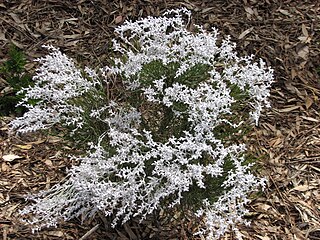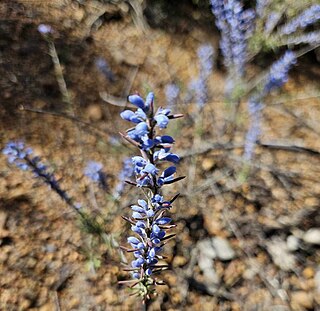
Conospermum acerosum, commonly known as needle-leaved smokebush, is a species of flowering plant in family Proteaceae and is endemic to the south west of Western Australia. It is spindly, erect or straggly shrub with needle-shaped or thread-like leaves, panicles of white or pink flowers and reddish brown nuts.

Conospermum glumaceum, commonly known as hooded smokebush, is a species of flowering plant in the family Proteaceae and is endemic to the south-west of Western Australia. It is an erect shrub with more or less clustered, linear leaves, and panicles of dense, head-like spikes of tube-shaped, cream-coloured flowers and white to golden nuts.

Conospermum stoechadis, commonly known as common smokebush, is a species of flowering plant in the family Proteaceae and is endemic to the south-west of Western Australia. It is an erect, compact shrub with thread-like leaves and spikes of woolly white, tube-shaped flowers.

Conospermum longifolium, commonly known as the long leaf smokebush, is a species of flowering plant of the family Proteaceae and is endemic to New South Wales. It is a dense shrub or undershrub with linear to narrowly lance-shaped leaves, panicles of white flowers and velvety, cream-coloured to dark brown nuts.

Conospermum ericifolium is a flowering plant of the family Proteaceae and is endemic to eastern Australia. It is a slender, erect shrub with linear leaves, panicles of cream-coloured to white flowers and hairy, golden nuts.

Conospermum mitchellii, commonly known as Victorian smokebush, is a species of flowering plant of the family Proteaceae and is endemic to the western half of Victoria. It is an erect shrub with crowded, linear leaves, panicles of white, blue or lilac flowers and orange or reddish brown nuts.

Conospermum ellipticum is a species of flowering plant in family Proteaceae and is endemic to New South Wales. It is an erect shrub with hairy, elliptic leaves, panicles of cream-coloured to white flowers and golden, hairy nuts.

Conospermum tenuifolium, commonly known as sprawling smoke-bush or slender wire lily, is a flowering plant of the family Proteaceae and is endemic to New South Wales. It is a low shrub with linear to lance-shaped leaves, panicles of pinkish white to mauve flowers and nuts with velvety white hairs.

Conospermum amoenum, commonly known as blue smokebush, is a species of flowering plant in the family Proteaceae and is endemic to the south-west of Western Australia. It is an erect or spreading shrub with linear leaves, and spikes of blue or white tube-shaped flowers.

Conospermum cinereum is a species of flowering plant in the family Proteaceae and is endemic to the south west of Western Australia. It is a spindly shrub with egg-shaped to lance-shaped leaves, loose spikes of woolly, tube-shaped white flowers and woolly nuts.

Conospermum crassinervium, commonly known as summer smokebush or tassel smokebush, is a species of flowering plant in the family Proteaceae, and is endemic to the south-west of Western Australia. It is a low, tufted shrub with clustered leaves arranged at the base of the plant and corymbs of spikes of white to grey, hairy, tube-shaped flowers.

Conospermum distichum is a species of flowering plant in the family Proteaceae and is endemic to the south-west of Western Australia. It is a shrub with ascending, thread-like leaves, and spikes of woolly white, tube-shaped flowers with blue bracteoles.

Conospermum eatoniae, commonly known as blue lace, is a species of flowering plant in the family Proteaceae and is endemic to the south-west of Western Australia. It is a spreading shrub with egg-shaped leaves only present on young plants, and panicles of glabrous blue, tube-shaped flowers with pale green bracteoles.

Conospermum flexuosum, commonly known as the tangled smokebush, is a species of flowering plant in the family Proteaceae and is endemic to the south-west of Western Australia. It is a sprawling shrub with many zig-zag branches, panicles of white to pale blue, tube-shaped flowers and urn-shaped, hairy nuts.

Conospermum leianthum is a species of flowering plant in the family Proteaceae and is endemic to the south-west of Western Australia. It is a shrub with thread-like leaves, and panicles of white and more or less purple, tube-shaped flowers.
Conospermum microflorum is a species of flowering plant of the family Proteaceae and is endemic to Western Australia. It is a rounded shrub with glabrous, thread-like leaves, panicles of woolly hairy, white or cream coloured flowers and woolly hairy, orange-brown nuts.
Conospermum petiolare is a species of flowering plant in the family Proteaceae and is endemic to the south of Western Australia. It is a tufted subshrub or shrub with dense, erect, narrowly oblong leaves, and panicles of velvety cream-coloured, orange-yellow or pink, tube-shaped flowers, the fruit a hairy, brownish-yellow to gold-coloured nut.

Conospermum hookeri, commonly known as Tasmanian smokebush, is a species of flowering plant in the family Proteaceae and is endemic to Tasmania. It is a shrub with many branches, spatula-shaped or linear leaves, panicles of spikes of white, tube-shaped flowers and reddish brown nuts covered with silky fawn-coloured hairs.

Conospermum patens, commonly known as the slender smokebush, is a species of flowering plant of the family Proteaceae and is endemic to south-eastern continental Australia. It is an erect shrub with crowded linear or spatula-shaped leaves, panicles of densely hairy white, bluish-grey or purplish flowers and hairy, yellowish-brown nuts.

Conospermum sphacelatum is a species of flowering plant of the family Proteaceae and is endemic to Queensland. It is an erect shrub with few branches, erect linear to narrowly egg-shaped leaves with the narrower end towards the base, hairy white flowers on the ends of branches, and white to cream-coloured nuts.



















